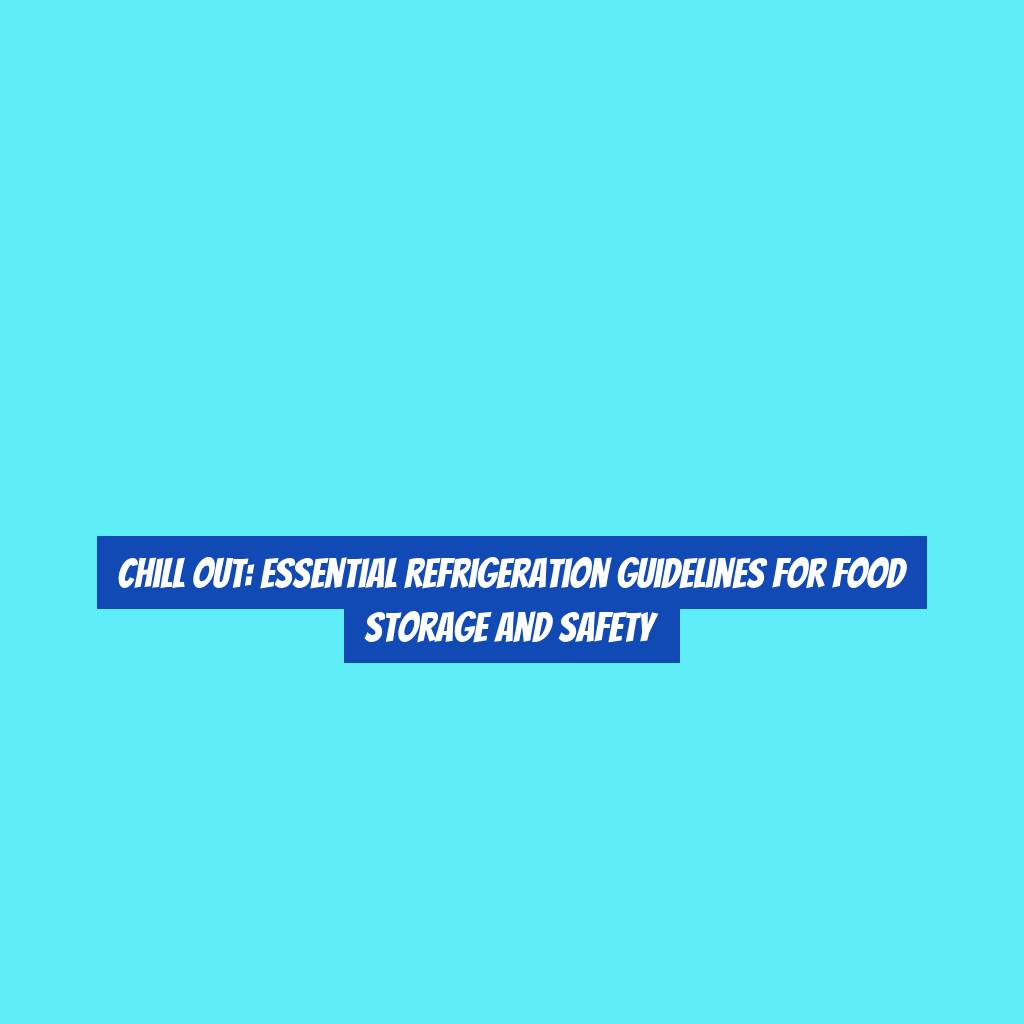Chill Out: Essential Refrigeration Guidelines for Food Storage and Safety
Did you know that the average American family throws away nearly 1,000 pounds of food each year? Proper refrigeration is key to reducing this waste and ensuring the safety of the food you consume.
From maintaining the right temperature to preventing cross-contamination, there are essential guidelines that can help you maximize the shelf life of your groceries and keep your family safe.
So, how can you make sure that your refrigerator is working for you and not against you?
The Importance of Proper Temperature
Maintaining the correct temperature in your refrigerator is essential for keeping your food safe and fresh. The ideal temperature for your fridge is 40-?F (4-?C) or below, while the freezer should be set at 0-?F (-18-?C).
These temperatures help to slow down the growth of bacteria, keeping your perishable items safe to consume. ItG??s crucial to invest in a refrigerator thermometer to ensure that the internal temperature remains within the recommended range.
Additionally, be mindful of where you place items in your fridge. Foods that require colder temperatures, such as dairy and raw meat, should be stored on the lower shelves where itG??s coldest. This prevents cross-contamination and ensures that these items remain at a consistent, safe temperature.
If your refrigerator door is constantly being opened and closed, it can lead to fluctuations in temperature. Be mindful of this and try to minimize the time the door is open.
Organizing Your Refrigerator for Efficiency
Now that you understand the importance of proper temperature control in your refrigerator, letG??s focus on organizing it for maximum efficiency.
A well-organized refrigerator not only keeps your food fresh for longer but also makes it easier to find items and reduces the risk of food spoilage.
Here are some essential tips to help you organize your refrigerator effectively:
-
Zone Your Refrigerator: Designate specific areas for different food categories such as dairy, meats, fruits, and vegetables. This not only streamlines your search for specific items but also helps maintain optimal storage conditions for different food types.
-
Utilize Storage Containers: Use clear storage containers to store smaller items like condiments, cheese, and deli meats. This not only maximizes space but also keeps the refrigerator tidy and makes it easier to clean spills.
-
Label and Date Items: Labeling and dating leftovers and other perishable items can help you keep track of what needs to be used first, reducing food waste and ensuring you consume items before they expire.
Understanding Food Storage Zones
To optimize your refrigerator organization, understanding the concept of food storage zones is essential for maintaining food freshness and minimizing waste.
Your refrigerator can be divided into specific zones based on temperature and humidity levels, which are crucial for preserving different types of food.
The top shelf is the warmest part of the refrigerator and is ideal for ready-to-eat items like leftovers, drinks, and deli meats. This area should be kept at or below 40-?F to ensure food safety.
The middle shelf is slightly cooler and is best for dairy products, such as milk, yogurt, and cheese.
The lower shelf is the coldest part of the fridge and is perfect for raw meat, poultry, and seafood, as it helps prevent cross-contamination with other foods.
The crisper drawers maintain higher humidity levels, making them suitable for storing fruits and vegetables.
Additionally, the door shelves experience temperature fluctuations, so itG??s best to store condiments, dressings, and other items with preservatives there.
Understanding these food storage zones will help you maximize the freshness and quality of your food while minimizing the risk of spoilage.
Tips for Extending Shelf Life
You can extend the shelf life of your perishable items by following simple guidelines for proper storage and handling in your refrigerator. Here are some tips to help you make the most of your foodG??s freshness:
-
Keep it cool: Ensure your refrigerator is set to the appropriate temperature, ideally between 35-38-?F (1.6-3.3-?C). This helps slow down the growth of bacteria and preserves the quality of your food.
-
Store smart: Utilize airtight containers or resealable bags to keep fruits and vegetables fresh for longer. This prevents moisture loss and maintains the crispness of produce.
-
Rotate regularly: Practice the G??first in, first outG?? rule. By placing newly bought items behind older ones, you can ensure that nothing gets forgotten and left to spoil.
Preventing Cross-Contamination
While maintaining proper refrigeration to extend shelf life, itG??s essential to minimize the risk of cross-contamination by following specific guidelines for safe food handling and storage in your refrigerator.
First, always store raw meat, poultry, and seafood in sealed containers or plastic bags on the bottom shelf to prevent their juices from dripping onto ready-to-eat foods.
Use separate cutting boards for raw meat and produce to avoid transferring bacteria from one to the other.
Additionally, ensure that your refrigerator is consistently kept at 40-?F (4-?C) or below to slow the growth of bacteria.
Be diligent about cleaning up spills and leaks promptly to prevent the spread of germs.
ItG??s also crucial to regularly clean and sanitize the shelves, drawers, and walls of your refrigerator to eliminate any lingering bacteria.
Remember to label and date leftovers to ensure timely consumption and discard any items that have passed their expiration dates.
Conclusion
So, keep your cool and follow these essential guidelines for proper refrigeration.
By maintaining the right temperature, organizing your refrigerator efficiently, understanding food storage zones, and preventing cross-contamination, you can ensure the safety and freshness of your food.
With these tips, you can extend the shelf life of your groceries and enjoy peace of mind knowing that your food is being stored and handled properly.
